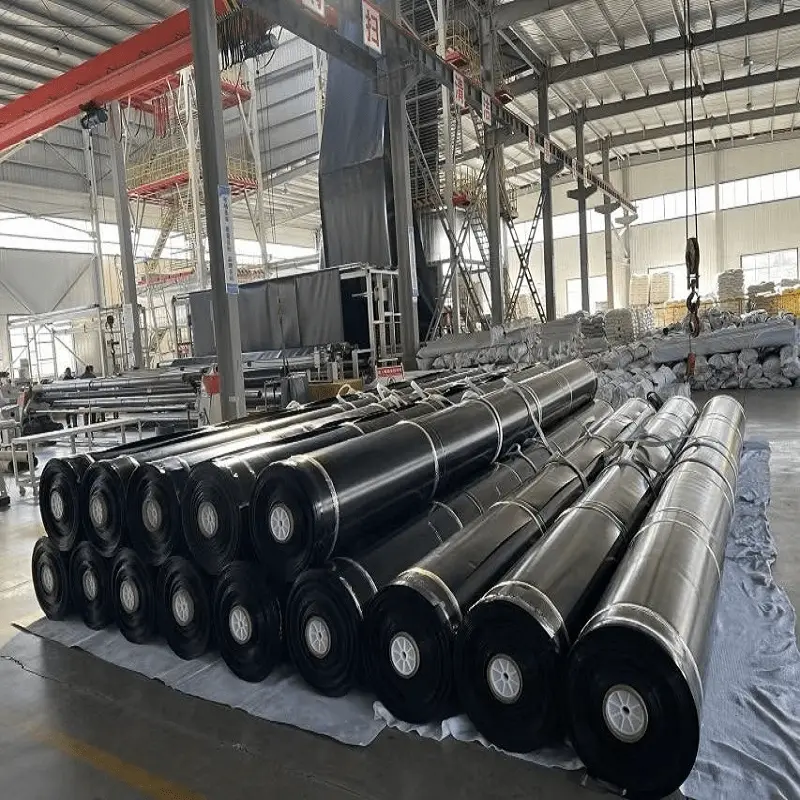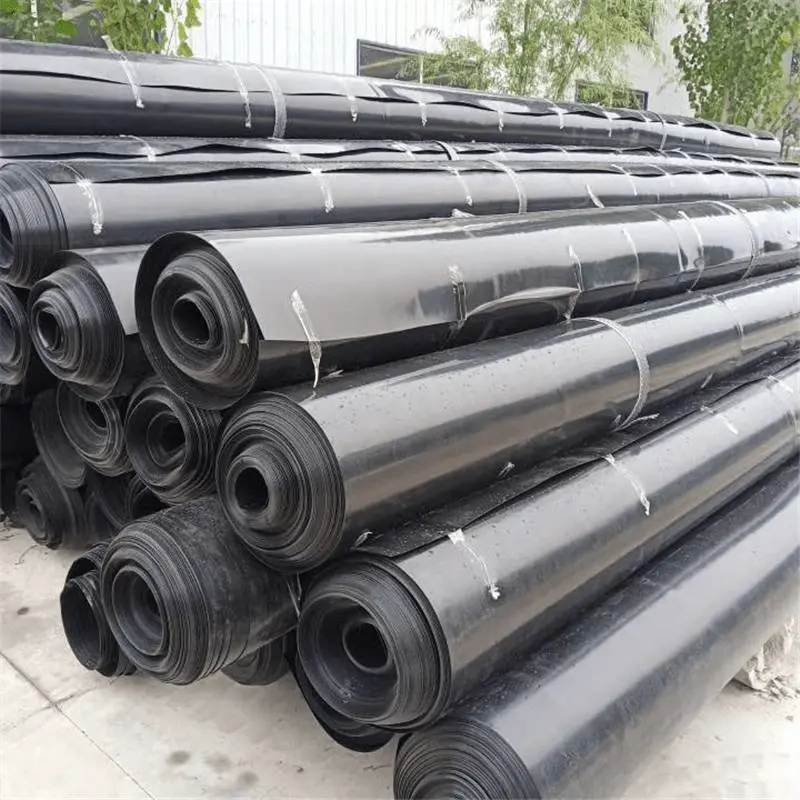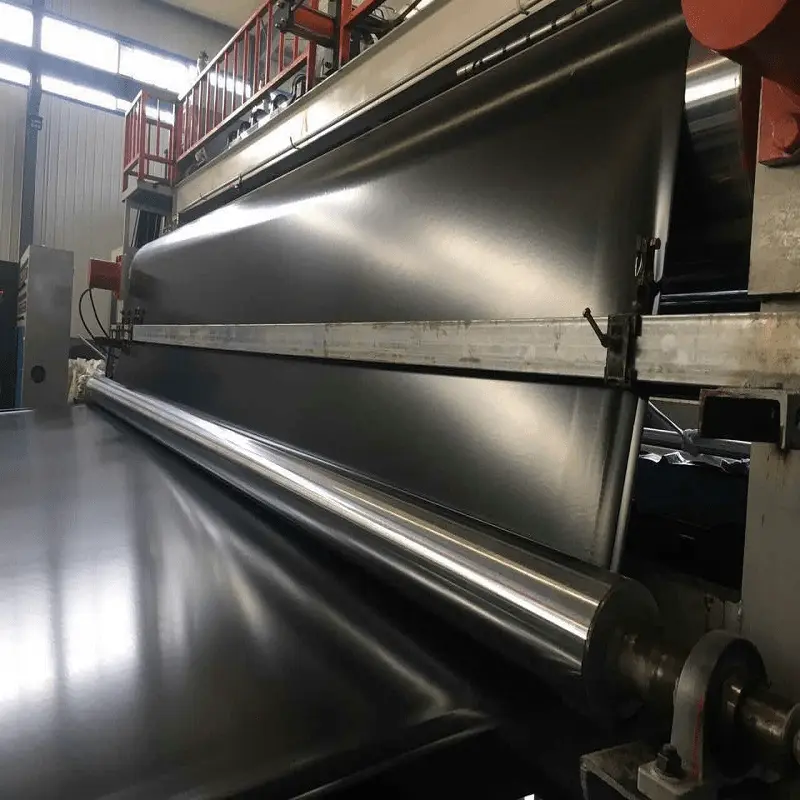I. Base Treatment
1. Cleaning and Compaction
Before construction, the base must be thoroughly cleaned to remove all sharp objects, gravel, weeds, roots, and other materials that could damage the geomembrane. The base surface should be smooth, free of cracks and loose soil, with a compaction coefficient of no less than 93%. For local irregularities, leveling and compaction should be performed to ensure the stability and bearing capacity of the base.
2. Slope and Stability
The base of the surrounding slopes should be structurally stable, with a slope allowance generally not less than 1:1.5 to prevent landslides or collapses during construction and operation. For areas with steeper slopes, appropriate reinforcement measures such as retaining walls or graded slopes should be taken.

II. Laying Precautions
1. Laying Direction and Method
The HDPE geomembrane should be laid first on the slope, from top to bottom, and then on the plane, from inside to outside. During laying, the membrane should not be pulled too tight, leaving some slack to prevent deformation and damage due to thermal expansion and contraction. Additionally, the membrane should be pressed flat and tightly against each other and the base surface to avoid gaps or bubbles.
2. Perimeter Treatment
The HDPE geomembrane should be tightly connected to the surrounding soil to block the entrance of seepage and cut off lateral seepage paths, preventing water from infiltrating beneath the geomembrane and forming bubbles. During laying, special attention should be paid to the connection between the geomembrane and structures such as vertical retaining walls, pump pits, and bridge foundations to ensure a reliable watertight seal.
3. Avoiding Contamination
The surface of the HDPE geomembrane must be free of dirt, fuel, splashed chemicals, and chemical stains, as these contaminants can affect its anti-seepage performance and welding quality. During laying, the geomembrane should be protected from oil, grease, and sharp objects. If contamination occurs, it should be promptly wiped clean with a clean cloth.

III. Welding Precautions
1. Welding Conditions
HDPE geomembrane welding should be performed under conditions with an average temperature of around 5°C, no rain, snow, or strong winds. If welding must be done in rainy weather, effective rainproof measures must be taken to prevent water from affecting the welding quality. Before welding, check that the welding equipment is in good working condition and ensure that the welding temperature and speed comply with specifications.
2. Welding Quality
The welding area should be free of dust, oil, and other impurities to ensure welding quality. When welding between membranes, a trapezoidal shape should be used to avoid cross-welding, which can reduce stress concentration and welding defects. During welding, strictly control the welding temperature and speed to ensure stable and reliable welding quality. After welding, inspect the weld seams for quality, and promptly repair any defects.
3. Repair Methods
Damaged HDPE geomembrane should be repaired promptly. Repairs should be made using materials of the same specifications, and the damaged area should be sealed with hot melt adhesive or polyethylene glue. After repair, quality checks should be performed to ensure that the repaired area meets the required anti-seepage performance.

IV. Anchoring Design
1. Choice of Anchoring Methods
The anchoring methods for HDPE geomembrane include anchoring trenches, strip fixation, and hot welding of embedded parts. Among these, anchoring trenches are commonly used due to their simple form and ease of construction. When selecting an anchoring method, consider the actual project conditions and geological conditions to ensure reliable anchoring effects.
2. Construction of Anchoring Trenches
The anchoring trench should be located at least 80cm from the edge of the slope. The trench section should be calculated based on the anchoring form and specific conditions, with a recommended size of not less than 80cm x 80cm. During trench construction, ensure that the trench walls are smooth, free of cracks and loose soil, and perform backfilling and compaction according to design requirements.

V. Protective Layer Design
1. Laying Nonwoven Geotextile
To prevent hard objects such as small stones and roots from puncturing the HDPE geomembrane, a nonwoven geotextile is typically laid on top as a protective layer. The nonwoven geotextile should have good tensile strength, tear strength, and permeability to ensure its protective effect on the geomembrane.
2. Riprap (or Concrete) Slope Protection
To improve slope stability and prevent sunlight from damaging the geomembrane, a riprap (or concrete) slope protection layer is designed on the outer surface. The slope protection materials should have good compressive strength and durability and be laid and fixed according to design requirements.
VI. Construction Management
1. Site Management
Set up clear safety warning signs and lights at the construction site to ensure the safety of construction personnel and machinery. Strengthen supervision and management of the construction site, strictly prohibiting smoking, ignition, and other behaviors that could cause fires. Keep stored geomembrane materials out of direct sunlight and away from fire sources.
2. Construction Quality Control
Strictly control the construction quality during the process, ensuring that all construction parameters and indicators comply with design requirements. Focus on monitoring and inspecting critical construction links and key nodes, promptly rectifying any issues found. Strengthen training and management of construction personnel to improve their professional skills and responsibility.
3. Quality Inspection and Acceptance
After construction, conduct quality inspection and acceptance work. Inspection items include tensile strength tests, weld quality inspections, etc. Sampling inspections should be performed according to specifications, ensuring the accuracy and reliability of test results. After passing the acceptance, promptly hand over the project and proceed with subsequent maintenance work.
VII. Conclusion
The construction of HDPE geomembrane is a complex and delicate project requiring strict adherence to various precautions and technical requirements. By enhancing base treatment, laying and welding quality control, optimizing anchoring design, and designing protective layers, as well as implementing effective construction management, we can ensure the quality and effectiveness of HDPE geomembrane projects. Additionally, this will improve project safety and durability, laying a solid foundation for long-term development.
Haoyang Environmental proudly offers premium HDPE geomembranes tailored for clients worldwide, ensuring quality that meets international standards. Our extensive range of geomembranes is designed for durability and reliability across various applications. We warmly welcome inquiries and orders from all corners of the globe, ready to serve your needs with professionalism and efficiency.

942.webp)
237.webp)
106.webp)